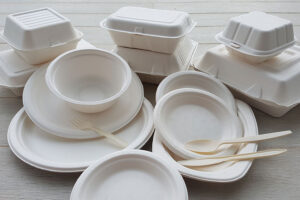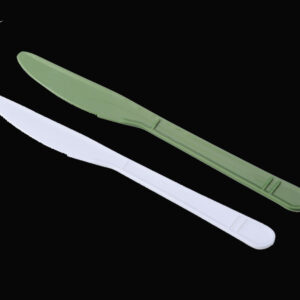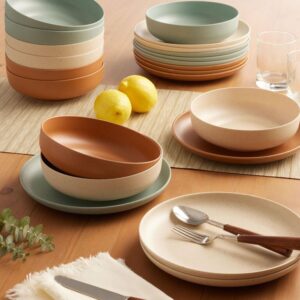Introduction
In recent years, the spotlight on sustainable living has intensified, shining a beam on the products we use daily, including our tableware choices. As consumers increasingly opt for eco-conscious alternatives, eco-friendly tableware manufacturers have risen to meet this demand, offering various products marketed as better for the environment. But the question lingers: Are these eco-friendly options superior to their traditional counterparts?

Types and Materials of Eco-Friendly Tableware
Eco-friendly tableware comes in various forms, each boasting its unique environmental benefits. Notably, biodegradable tableware from plant-based materials such as cornstarch has been widespread. Cornstarch tableware manufacturers have innovated products that not only serve the purpose of traditional silver but also promise a lesser environmental footprint.
Other materials include bamboo, palm leaves, and sugarcane bagasse. Each material presents a sustainable alternative to the conventional petroleum-based plastics used in disposable tableware manufacturing. These materials decompose much quicker and with less environmental impact than traditional plastics.
Comparison Between Eco-Friendly and Traditional Tableware
When comparing eco-friendly tableware with traditional options, several factors come into play. Cost, durability, and functionality are crucial aspects to consider. While it’s true that eco-friendly options, such as those offered by custom disposable cornstarch tableware manufacturers, may come with a higher price tag, they offer significant environmental benefits.
While cheaper and sometimes more durable, traditional plastic tableware poses a significant threat to the environment due to its non-biodegradable nature. On the other hand, eco-friendly alternatives decompose much faster and have a lower carbon footprint during their lifecycle. For example, cornstarch-based tableware decomposes in months under the right conditions, compared to centuries for plastics.
Production and Sales Trends in Eco-Friendly Tableware
The market for eco-friendly tableware has seen a substantial upswing in recent years. As awareness about environmental issues grows, more consumers are turning towards sustainable options. Eco-friendly tableware manufacturers have observed a steady increase in demand, with a notable rise in the popularity of products like biodegradable cornstarch tableware.
This shift isn’t just a consumer trend; it’s also reflected in the business strategies of disposable tableware manufacturers. Many now incorporate eco-friendly lines into their product offerings, recognizing the growing market demand. The global supply chain for these products has expanded, making them more accessible to a broader audience. This trend reflects an increasing recognition of the need for sustainable practices in everyday products.
Environmental Impact of Eco-Friendly Tableware
The environmental impact of tableware, particularly when comparing eco-friendly options to traditional ones, is a complex subject. Eco-friendly silver, mainly made from materials like cornstarch, significantly reduces the environmental burden. Cornstarch tableware manufacturers emphasize how these products decompose at the end of their life cycle into natural elements, unlike plastic, which has remained in landfills for centuries.
However, it’s crucial to consider the entire lifecycle of these products. This includes the resources used in their production and the energy expended in manufacturing and distribution. While eco-friendly tableware is undoubtedly better for the environment post-consumer use, the total environmental impact can vary based on how the products are produced and transported.
Consumer Perspectives and Market Acceptance
Understanding consumer attitudes towards eco-friendly tableware is critical to evaluating its market acceptance. Consumers are increasingly environmentally conscious, and many are willing to pay a premium for products that align with these values. Products from custom disposable cornstarch tableware manufacturers resonate with these eco-conscious consumers, allowing them to align their dining habits with their environmental beliefs.
However, challenges exist in terms of cost and availability. While the demand for eco-friendly tableware is growing, it is often more expensive than traditional options, which can be a barrier for some consumers. Additionally, availability can be an issue, especially in areas where eco-friendly products are less readily accessible. Despite these challenges, the general trend shows a growing acceptance and desire for sustainable tableware options.
Regulations and Standards for Eco-Friendly Tableware
The surge in the popularity of eco-friendly tableware has led to increased scrutiny of regulations and standards. Governments and environmental agencies have started implementing more stringent rules to ensure that the products labeled as ‘eco-friendly’ genuinely live up to their name. This regulatory framework is crucial for maintaining the market’s integrity and guiding eco-friendly tableware manufacturers in their production processes.
Standards for biodegradability, compostability, and sustainable materials are critical in these regulations. They ensure that products like those produced by cornstarch tableware manufacturers reduce environmental impact during their use and in their production and disposal. These regulations are vital for consumer trust, ensuring that they make a genuinely environmentally beneficial choice when they choose eco-friendly tableware.
Future Outlook for Eco-Friendly Tableware Industry
The eco-friendly tableware industry is poised for ongoing growth and innovation. The potential for new and improved products is vast with advancing technology and increasing environmental awareness. Innovations in materials and manufacturing processes will likely make eco-friendly options like biodegradable cornstarch tableware more sustainable and accessible.
The industry is expected to evolve in response to consumer demand and environmental challenges. This could include further reductions in the carbon footprint of production processes, increased use of recycled materials, and even more excellent biodegradability. As the industry grows, disposable tableware manufacturers are anticipated to expand their eco-friendly lines, making these products a staple in households and businesses worldwide.

Conclusion
In answering the question, “Are eco-friendly tableware options better?” the evidence leans towards a positive affirmation. While challenges such as higher costs and varying levels of environmental impact in production exist, the benefits of products like those from cornstarch tableware manufacturers are precise. These products offer a sustainable alternative to traditional tableware, aligning with the growing global emphasis on environmental responsibility.
Ultimately, the shift towards eco-friendly tableware is not just a consumer trend but a necessary step in our collective journey toward sustainability. As technology advances and regulatory frameworks strengthen, the eco-friendly tableware industry is set to play a pivotal role in shaping a greener future. By choosing eco-friendly options, consumers and businesses can significantly reduce environmental impact, one meal at a time.







